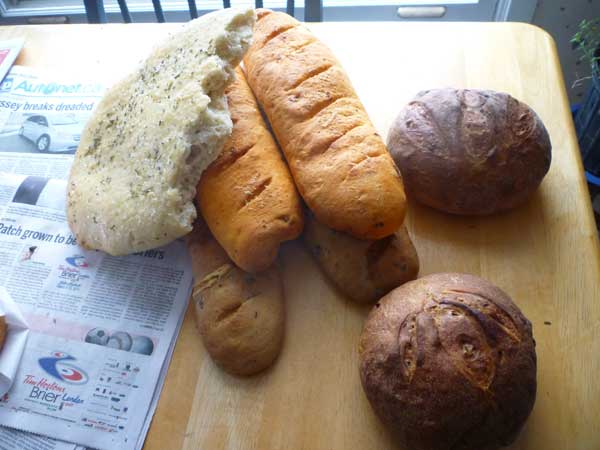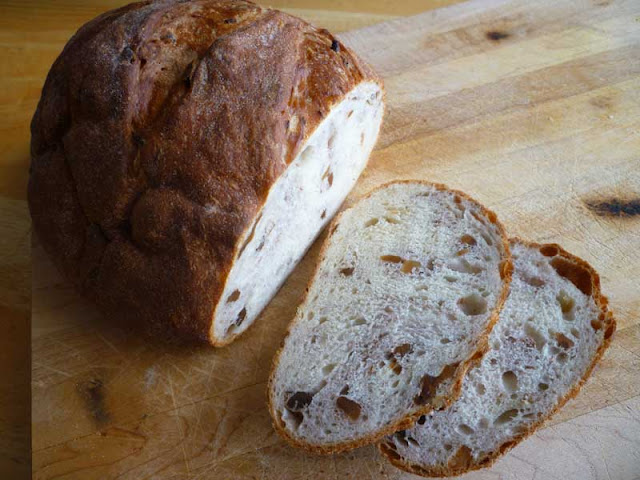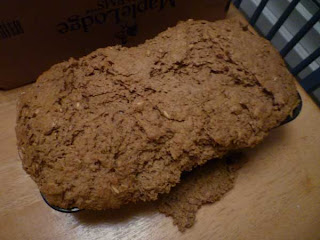I get Professional Help for my Addiction - #1
This bread making course is a rather intensive 2-day course, and our instructor is one of the chefs at the college's Culinary Arts program. When I say it is intensive, I don't mean that the loaves we made were difficult or time consuming. No, I just mean that we moved along fairly rapidly, and made a total of 4 different doughs in one solid day of baking. I didn't have a lot of time for taking pictures.
This course is something my wife and I have done together, on this cold Saturday in February. We have been looking forward to it for a long time now -- almost like a vacation. And although I was warned by several people that I probably wouldn't learn anything I didn't already know, I expected to learn quite a bit. And I wasn't disappointed.
Chef Stephanie has been teaching for eight years, and has had lots of baking experience before that. Many of the restaurants that she worked in serve Mediterranean meals, and some of her favourite breads are in the Mediterranean style. That is what we worked on today, for our first lesson.
She handed out some recipes and an apron to each of us, and we began. I have posted the recipes from day one here, in case anyone else wants to peruse them. They are volume measurements, not recipes given by weights. (I may be able to get the weight measurements from her, I'll see).
Chef started us off with a Rosemary Focaccia, which I thought was a great idea because there is virtually no forming of the dough: you just mix the ingredients, get a feel for it, let it bulk ferment, and then press it onto a pan.
 |
| My focaccia |
While it is proofing the second time, we were making our second dough, essentially the very same ingredients, only this time we added Sundried Tomato and Chevre (Goat Cheese). Here, she showed us how to roll up the dough with the cheese inside it. It is essentially the same as pushing down the dough like we did the focaccia, but instead of proofing it like that, we sprinkled some cheese on the bread and rolled it up like a log.
 | |
| I got to use a dough hook on a mixer, first time ever: mostly, I do all my kneading by hand |
My sundried tomato and chevre loaves: before the final proof, and after baking
While that was proofing, and we were baking our focaccia, we made the same loaf using Black Olives and Gorgonzola Cheese. By now we were getting the hang of it. This was made exactly the same way as the Sundried Tomato and Chevre loaf. The interesting thing about these loaves, I thought, was the way she had us brush olive oil on the tops, and score the loaves BEFORE the final proofing. I had always only ever scored my loaves just prior to putting them in the oven. For these loaves, this pre-scoring worked well, although I really didn't see any meteoric oven spring on any of my loaves.
 |
| My olive and gorgonzola loaves, before proofing and after baking |
The final loaf of the day was a Walnut and Caramelized Onion Loaf, which she allowed us to make into a free-form loaf. I made my dough into a couple of smaller boules, and they retained their shape and didn't sag out over the parchment paper, like some of my whole wheat doughs do. If you use bread flour, bread is a lot easier to form.
 |
| Walnut and Carmelized Onion Loaves |
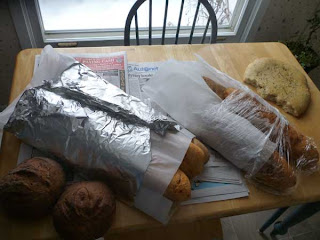 |
| Almost the entire haul of bread, made between the two of us |
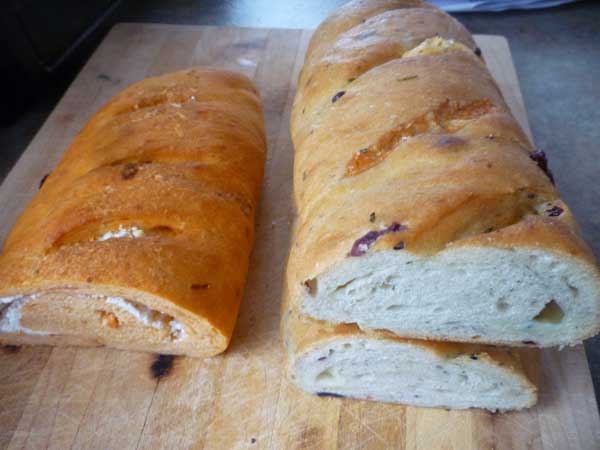 |
| These loaves squished down a bit on the ride home. Imagine, we forgot to take some bags with us. Next time, we won't forget |
The breads we made today are easy to make, and they taste good. They do, however, all use bread flour or all-purpose flour. My interests, as I have been blogging and baking, have turned almost exclusively to whole grains, but it is good to make other breads once in a while to remind oneself of the possibilities. I am not sure whether the bread recipes that Chef gave us will translate well to whole grain flours, but I am sure going to give it a try. (I already have a whole wheat focaccia recipe that turned up recently on the Fresh Loaf blogs by Marie H that I want to experiment with!)
Addendum:
The next day, we cut into the Walnut and Caramelized Onion Loaf. We both think that this is the best of the loaves we made. The Onion imparts a nice scent and a surprising amount of sweetness. The roasted walnuts provide texture and colour (they leave the white bread stained a bit purple -- the digital photos here don't quite deliver that colouration, unfortunately), as well as an interesting taste. This is a nice bread, almost like a desert bread, it is so sweet. You can't eat this all the time, it is far too starchy. But it is nice as a treat.
I am thinking that a whole wheat version of this might work, too.
 |
| Best of the Four Breads: Walnut and Caramelized Onion Loaf |
Notes to Myself
- Get the weight measurements for these recipes, and then see if it will translate to whole grains.
- What is the advantage of scoring prior to the final proofing, vs scoring just before putting the bread in the oven? It is possible that the late scoring will deflate the dough somewhat. It is possible though, that you won't get as high an oven-spring if you score it too early. Hmm.

